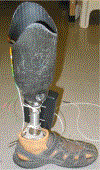A Novel Measurement Device for Volume Management in Lower Limb Amputees: A Technical Note
- PMID: 32685938
- PMCID: PMC7368665
- DOI: 10.1109/memea.2013.6549746
A Novel Measurement Device for Volume Management in Lower Limb Amputees: A Technical Note
Abstract
Many amputees suffer from irritation and wounds as a result of poor residual limb volume management. Reasons contributing to failure to maintain volume properly include peripheral neuropathy, cognitive impairment, and social/cultural issues. Amputees commonly use socks of various thicknesses to account for diurnal limb volume loss. However, data relating to sock compliance is lacking due to an absence of a reliable way to collect usage data. A device was fabricated utilizing wireless RFID and socket-limb interface force detection technology to track sock usage and activity of an amputee. Pilot data was collected through both in-lab and out-of-lab protocols. The collected data showed encouraging results tracking interface force data, however accurate sock data collection was difficult. Suggested solutions include designing a more effective antenna and using the interface force data to detect limb presence to start a tag accumulator algorithm. Clinical applications for the Sock Monitor include intervention through alerting the amputee of a need for a sock change before tissue damage occurs and evidence for prosthetists to justify insurance reimbursement for components and socket replacements. The next step is to use a new prototype with better hardware and firmware to collect real-world usage data from a large group of amputees. A predictive model will be made and implemented to determine if intervention in sock usage improves comfort and limb tissue health.
Keywords: RFID; monitoring; prosthetics.
Figures





References
-
- Stepien JM, Cavenett S, Talyor L and Crotty M, ”Activity Levels Among Lower-Limb Amputees: Self-Report Versus Step Activity Monitor,” Archives of Physical Medicine and Rehabilitation, vol. 88, no. 7, pp. 896–900, 2007. - PubMed
-
- Zachariah SG, Saxena R, Fergason J and Sanders JE, ”Shape and volume change in the transtibial residuum over the short term: Preliminary investigation of six subjects,” Journal of Rehabilitation Research & Development, vol. 41, no. 5, pp. 683–694, 2004. - PubMed
-
- Dillingham TR, Pezzin LE, MacKenzie EJ and Burgess AR, ”Use and Satisfaction with Prosthetic Devices Among Persons with Trauma-Related Amputations: A long-term Outcome Study,” American Journal of Physical Medicine and Rehabilitation, vol. 80, no. 8, pp. 563–571, 2001. - PubMed
Grants and funding
LinkOut - more resources
Full Text Sources
Miscellaneous
